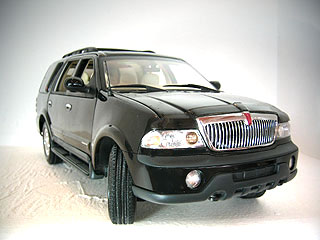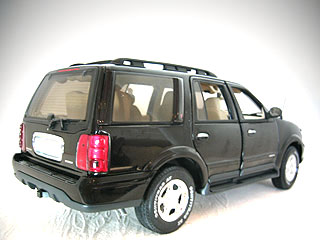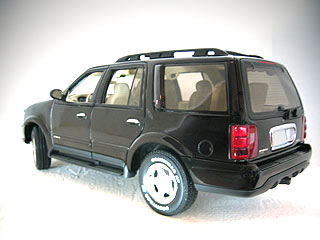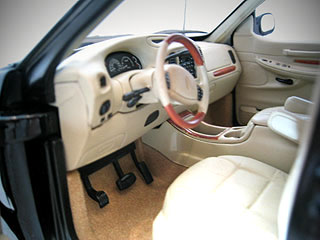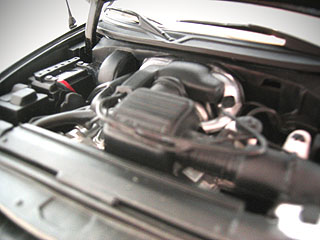Exterior Features, Quality:
When it was first shown at the 1997 NAIAS, critics believed that the Navigator, a dressed-up luxury version of the truck-based Expedition, would flop. Instead, it was a sales success, and in my opinion, represents the audacity and sheer presence of the Lincoln cars of yesteryear, with luxury features up to the teeth. This model represents the first generation of the Navigator, produced from 1998-2002.
Let's get something straight here: this is not a new mold. Instead, like the 1:1, the Navigator is based on the UT Expedition model, which was already an amazing piece. Whether it is as good if not better, you shall find out. For one thing, it is huge, making an even bigger impression than the Expedition model. Perhaps it's the copious use of chrome, sheer bulk, or that awesome black paint. Speaking of paint, it's really well done, with flawless distribution and perfect finish. It's one feature of the model that I really really like. Front lights are nicely detailed with realistic-looking bulbs and superb shape. The immense grille is chromed very nicely and is perforated, which is always good. Fog lights are very detailed as well. The actual plastic pieces are superb, with excellent finish.
Tires are marked Contitrac AT, and the chrome wheels look really cool. Brake disc detail is surprisingly abysmal and there are no brake calipers, just like on the UT Expedition. Door handles are exquisitely done, nicely chromed, and very accurate. Autoart deserves to be commended for the excellent window tint, which makes the model look even more realistic. However, here's where we run into trouble, specifically cost-cutting. The outer portion of the rear lights is borrowed from the UT Expedition, but is not true to the rear lights of the 1:1 Navigator. In other words, Autoart tried to save money and they messed up. Furthermore, the portion of the rear lights that is correct has ugly visible attachment stubs. The backlight is a sticker. There are good things back here too, like the beautiful license plate area which is chromed off, and features two clear lights, which look superb. Furthermore, the rear window wiper is quite detailed. A look at the undercarriage reveals that the exhaust pipe is not even hollow. Hmmm...not too good, I'm afraid, and certainly outside the norm of most Autoart models.
19/25
Interior Features, Quality:
The eye-catching interior of the Navigator is far more to my liking, realism-wise. For one, it features a really rich and realistic carpet. It really adds to the model as a whole, and it feels far more like a collector's piece than a toy. The dash has excellent detail, and the wood is quite realistic. Steering wheel is nicely shaped and has good detail. Cupholders have superb shape and are nicely integrated into the plastic. Seats look very realistic, with creases and a good shape, but they lack texture or softness. Furthermore, lights around the door are stickers. The ceiling is actually finished, but not only that, textured, as well as the backs of the seats, definitely a great touch. Moving armrests are also a superb feature that is not really needed, but definitely enhances the feel of the cabin. Overall, very well done, though still short of my usual Autoart expectations.
23/25
Features:
The Navigator features an opening hood, doors, tailgate, and moveable armrests in the interior. It's pretty hard to get the hood to stay up but when pushed enough, it will stay. Good thing too, as engine detail is really outstanding, the engine being wired and plumbed. Although it is quite dark, you can make out a lot of detail, and there are several markings place around the engine area. Although it seems like this is the same as the UT Expedition's engine, it is obvious that Autoart added detail and refinement so as to justify the increase in price over the UT. Doors use different styles of hinges, the fronts using the familiar doglegs while the rears use new-style hinges, which are a bit flimsy in my example. Doors do not have windows which makes for easy opening but does not look as realistic as models which feature windows. The tailgate does not open very far at all, not even enough to get a good view of the trunk. The tailgate also doesn't hold in place, which is a shame, as the carpeted and textured trunk is a really nice portion of the model. As for those folding armrests, they're a really nice touch, which I appreciate, but the resources could have been used elsewhere, like to rectify the rear light problems. Still, I'm not complaining...well, not really.
24/25
Value:
Well, how difficult is it to justify the value of a model based on another model that costs twice as much but is not as good? Not as difficult as you would think. The Autoart really makes an impression, and some collectors would pay just for that. Its rich black paint, superb interior detail, and excellent engine would be reason enough for most to pay the entry fee, For its price, one would expect more. Don't count out rarity either. Interestingly enough, Autoart Navigator models aren't selling that well which might mean a higher price in the future as demand starts to rise. Keep in mind that no one else makes a Navigator in 1:18 scale, and white is the only other color offered.
24/25
Overall:
It didn't make that much sense to critics in 1997 that the Navigator would sell for almost twice the price of the Expedition. Funnily enough, it doesn't make much sense to me that the Navigator, made by Autoart, basically the upmarket successor of UT, is not as nice a model as the UT Expedition. For an Autoart, it is definitely a rung down the ladder in terms of realism, specifically because of cost cutting, which is not something I want to see at the premium price point. Still, let's not count this Navigator model out. Its virtues have been listed above, and it's actually a very good model. It's just that it could have been better.




